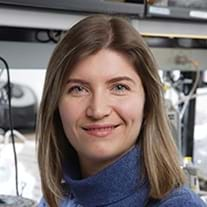The Research Behind Neurons and Cell Behavior
The Innovators in Science Award Honorees are Breaking New Ground in Neuroscience: Dr. Viviana Gradinaru’s research enables scientists to visualize neuron and cell behavior.
Published May 1, 2018
By Anni Griswold
NYAS Contributor
Albert Einstein reportedly once said, “Not everything that can be counted counts, and not everything that counts can be counted.” Though the 2017 honorees of the Innovators in Science Award have plenty of countable achievements, their stories reveal a common thread — creative approaches to their work and the development of disruptive tools that transformed scientific understanding in their discipline.
Illuminating the Brain’s Circuitry

As an undergraduate, Viviana Gradinaru, PhD, the Early-Career Scientist Winner, became fascinated with the underpinnings of neurodegeneration. But few tools existed to dissect the phenomenon. Undeterred, she set out to create her own.
During graduate school, Gradinaru borrowed light-sensitive proteins from algae and bacteria and introduced them to mammalian neurons. Her hope was to switch individual cells on or off in response to laser stimulation. Using this strategy, she revealed how specific brain circuits underlie locomotion, reward and sleep. One of Gradinaru’s tools, dubbed “eNpHR3.0,” is now widely used in the field of optogenetics — a field that her work helped launch.
Now an Assistant Professor of Biology and Biological Engineering at Cal Tech, Gradinaru has moved on to other tools and methods. This includes tissue-clearing techniques that render organs transparent. These see-through systems allow scientists to visualize where neurons start and stop. They also study how the cells behave along the way.
Gradinaru’s team was also among the first to introduce vectors that can shuttle genes across the blood-brain barrier with high efficiency. These genes can express colors. This allows scientists to visualize neural pathways, or they can normalize biochemical or electrical properties in a disease model.
“Developing tools and perfecting them to the level where they can work in other people’s hands,” she says, “is key to maximum impact.”
Ultimately, Gradinaru says she hopes these tools will inspire non-invasive therapies that can repair faulty brain circuits and address issues such as neurodegeneration.
Read more about Innovators in Science Award Honorees:
- Ben Barres: The Innovators In Science Award Honorees Are Breaking New Ground In Neuroscience
- Michael Halassa: The Innovators In Science Award Honorees Are Breaking New Ground In Neuroscience
- David Julius: The Innovators In Science Award Honorees Are Breaking New Ground In Neuroscience
- Shigtada Nakanishi: The Innovators In Science Award Honorees Are Breaking New Ground In Neuroscience
- Kay Tye: The Innovators In Science Award Honorees Are Breaking New Ground In Neuroscience
